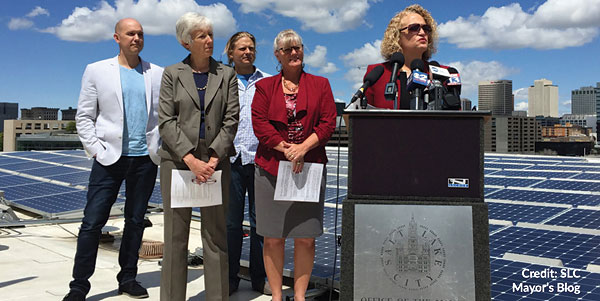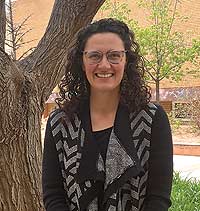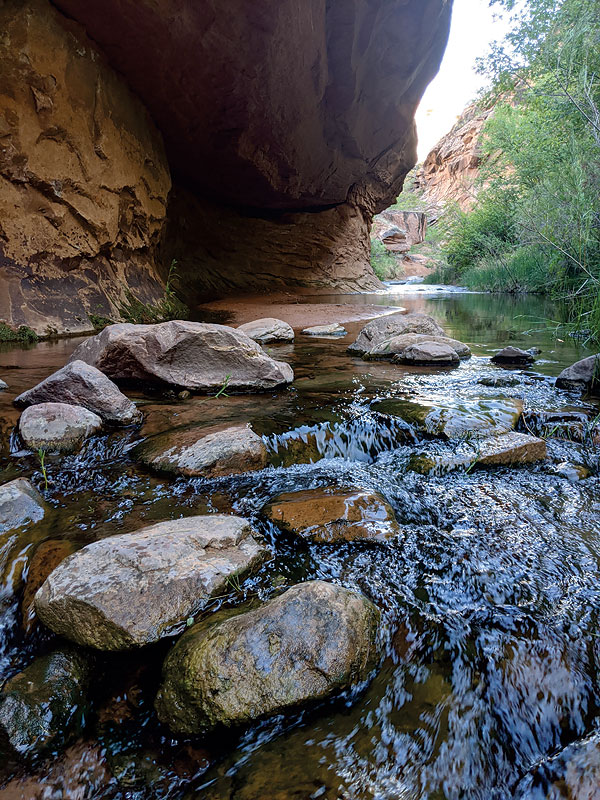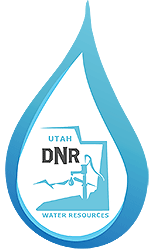|
|
SUSTAINABILITY HAPPENINGS June 2021
|
Running on Renewables:
Moab Helps Lead Push for Sea Change in Utah’s Energy Grid
Roslynn Brain McCann, Sustainable Communities Extension Specialist |
Many are shocked to discover that 23 cities and counties in Utah have resolved to adopt 100 percent net-renewable electricity resolutions by 2030, representing almost 40% of Utah’s electricity grid. This shift is putting pressure on the largest energy provider in the west, Rocky Mountain Power, to divest away from fossil fuel-based energy dependence.
What does a 100% net-renewable electricity resolution mean? In simple terms, this entails meeting the city’s total electricity demand with the gross amount of electricity generated and purchased from renewable sources (such as solar, wind, and geothermal as well as energy efficiency, demand management, and energy storage). In the US, over 150 cities, counties and states have passed such resolutions.

And committing to achieving 100% isn’t an empty promise lacking delivery; six cities already have achieved this goal: Kodiak Island, Alaska; Aspen, Colorado; Georgetown, Texas; Greensburg, Kansas; Rock Port, Missouri; and Burlington, Vermont. Park City, Utah, is on track to exceed their 2030 goal and should be at 100% within just a couple of years.
Here in Moab, our city recently hired a new sustainability director, Mila Dunbar-Irwin, to help us achieve this resolution. A major development this year is that Grand County will participate as an “anchor community” in Utah’s Community Renewable Energy Program, made possible by 2019 HB 411. As an anchor community, our county will commit to a price that allows all eligible communities to partake with the assurance that the price will not rise above a set threshold.
With the help of a graduate student, we investigated how cities like Moab were able to successfully pass and work towards achieving such resolutions. What we found were four major strategies used to build community support. First, champions and early adopters were identified. In Moab, this includes leaders within our city government, but also local businesses such as Red Rocks bakery and KZMU Community Radio (powered by 100% solar energy). Next, the cities we researched were empowering businesses and individuals in the community to participate in a variety of energy and sustainability-related opportunities via active educational outreach campaigns. Both Park City and Moab have developed community challenges to encourage citizens to establish commitments to sustainable behaviors, and more of this will likely emerge with our new sustainability director. Next, cities are working to make engagement convenient. An example from one of our study participants is that “[Salt Lake City] waived permit fees for solar installation last year as a city for all of our residents.” In general, these cities are simplifying the processes for engaging in sustainable choices, such as solar installations, and increasing accessibility to information about energy efficient appliances. Reducing complexity and increasing accessibility are important characteristics of what makes a program or action convenient. Lastly, each city we researched was effectively developing partnerships to leverage resources. Want to find out more, or figure out how you can engage in this issue? Contact our local city government.
Note: This piece was adapted from How Utah cities are pursuing 100% renewable energy by Emily Skill, Ed Stafford, and Roslynn McCann, published in GreenBiz
/www.greenbiz.com/article/how-utah-cities-are-pursuing-100-renewable-energy
|
|
Alert! Alert! This is not a Test!
by Mila Dunbar-Irwin, Moab City Sustainability Director. |

Utah is in a State of Emergency due to drought conditions, as declared by Governor Cox on March 17, 2021. The year 2020 was one of the hottest and driest years on record, and our snowpack did not deliver relief this winter. Don’t worry just yet – with smart conservation actions and conscientious use, we should come through just fine. Whether you’re just visiting or are a full or part-time Moabite, keep reading for what you can do to help!
1) THINK ABOUT WATER! Sound easy? Good! The best thing you can do is to foster a water conservation mindset and think about your use. Turn off the tap while you soap your hands. Fill the sink to do dishes instead of letting the water run. Do only full loads of laundry. Hop right in the shower and make it snappy. Little actions like this create awareness in your daily life and lead us to be conscientious water-users – as we should be in the desert during a drought!
2) CHECK YOUR LANDSCAPE. If you water plants or a lawn outside, check your system for leaks, make sure you’re not watering more than you need to (look for puddles or run-off), and think about reducing the amount of water you’re using in other ways. If you’re ready for a change of scenery, think about replacing turfgrass lawn with a beautiful, desert-appropriate xeriscape full of native plants and flowers. 
3) CHANGE YOUR FIXTURES. Ready for an upgrade to that old bathroom faucet? Check out WaterSense labeled products and find the best option for you. Replacing old faucets, or even just the aerator in your faucet, can save an average family 700 gallons of water per year! That’s savings for our aquifer and your bank account too. Toilets are another great option to swap out for a more efficient model if you’re feeling really inspired.
4) CLEAN WITH A BROOM, NOT A HOSE. Instead of hosing down a sidewalk or driveway to clean it, consider using a broom instead. You get exercise, and an average of 80 gallons of water stays in the ground.
5) USE and REUSE. Wash the dog on the lawn that needs watering, then skip that watering cycle. Time the kids’ sprinkler play session to coincide with a regular scheduled watering. Cover your pool when you’re not using it to reduce evaporation. Use your pasta water to water your plants. Get creative!
 If we all become more Water Wise we can conserve water without sacrificing our quality of life and come together as a community to keep our water resources at a healthy level. Visitors can help out by being conscientious users too – re-use the linens in your room, be conscious of running taps, and tell the manager where you’re staying if you see an opportunity for more water conservation. For more information, contact Moab City’s Sustainability Director at sustainability@moabcity.org. Thank you for your help in conserving our most precious resource! If we all become more Water Wise we can conserve water without sacrificing our quality of life and come together as a community to keep our water resources at a healthy level. Visitors can help out by being conscientious users too – re-use the linens in your room, be conscious of running taps, and tell the manager where you’re staying if you see an opportunity for more water conservation. For more information, contact Moab City’s Sustainability Director at sustainability@moabcity.org. Thank you for your help in conserving our most precious resource!
And be sure to mention you read about it in Moab Happenings.
|
New Water Conservation Website
Kim Wells, Public Information Officer, Utah Division of Water Resources |
The City of Moab announces that Mila Dunbar-Irwin has been selected as the City’s new sustainability director. April 12 was her first day on the job.
As the sustainability director, Dunbar-Irwin will focus on multiple efforts including water conservation, reducing greenhouse gas emissions, and helping the City work toward its goal of reaching 100 percent net-renewable electricity by 2030. She will also develop sustainability plans and work to implement new, strategic environmental initiatives and policies to create cost savings for the City, as well as developing strategic partnerships, and overseeing sustainability outreach and volunteer activities.
“Mila brings a wealth of ideas and experience to the City,” said Moab City Manager Joel Linares. “We are pleased to be moving forward with developing, assessing, and implementing a variety of goals, programs, and practices to help make our City and our community more sustainable for generations to come.”
Dunbar-Irwin has lived in Moab for almost two years and worked for the Grand County planning department for most of that time. She came to Moab from Jackson, Wyoming, where she was a land-use planner in the private sector. She has also worked in ecological restoration and research and was an environmental educator and naturalist guide for 15 years. She holds an undergraduate degree in ecology from Yale University and a Master of Science in ecology from the University of California-Davis. Since arriving in Moab she has also volunteered with Science Moab as program director.
“I couldn’t be more excited to work with the Moab community and the excellent team at the City to pave the way for a sustainable future in Moab,” Dunbar-Irwin said. “Sustainability is such a broad and inspiring area, encompassing everything from water conservation to affordable housing policy and alternative transportation. In my short time here, I’ve fallen in love with Moab and its wonderful community and am honored to be part of shaping what our future looks like. My background in ecology, environmental education, restoration, and land use planning gives me a broad skill-set to support the City’s sustainability goals and work with the community to create our vision for the future.”
|
|
|
|
|
|
© 2002-2024 Moab Happenings. All rights
reserved.
Reproduction of information contained in this site is
expressly prohibited.
|
|



 If we all become more Water Wise we can conserve water without sacrificing our quality of life and come together as a community to keep our water resources at a healthy level. Visitors can help out by being conscientious users too – re-use the linens in your room, be conscious of running taps, and tell the manager where you’re staying if you see an opportunity for more water conservation. For more information, contact Moab City’s Sustainability Director at sustainability@moabcity.org. Thank you for your help in conserving our most precious resource!
If we all become more Water Wise we can conserve water without sacrificing our quality of life and come together as a community to keep our water resources at a healthy level. Visitors can help out by being conscientious users too – re-use the linens in your room, be conscious of running taps, and tell the manager where you’re staying if you see an opportunity for more water conservation. For more information, contact Moab City’s Sustainability Director at sustainability@moabcity.org. Thank you for your help in conserving our most precious resource! 